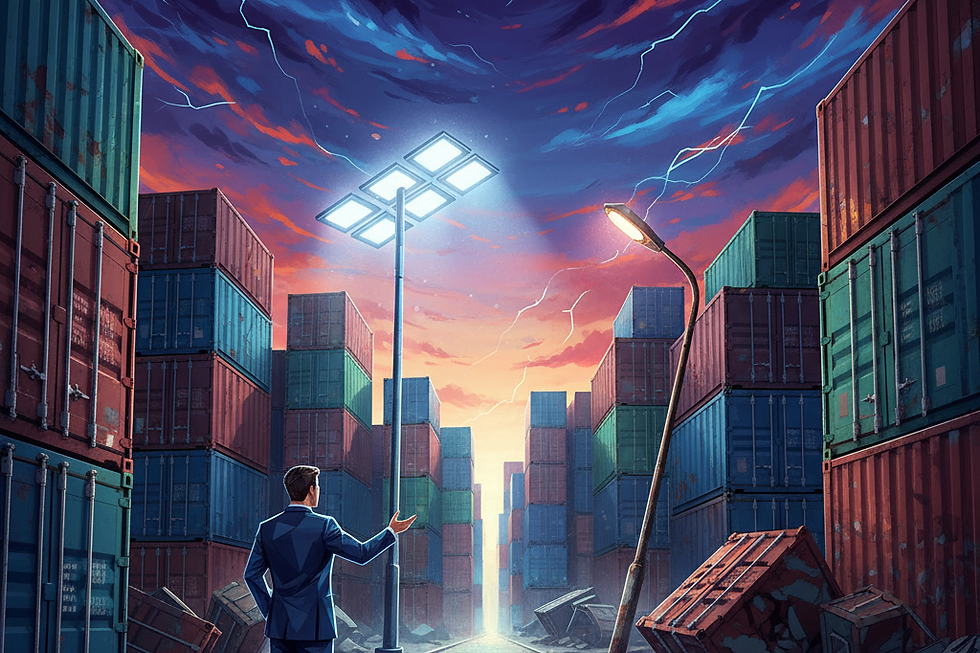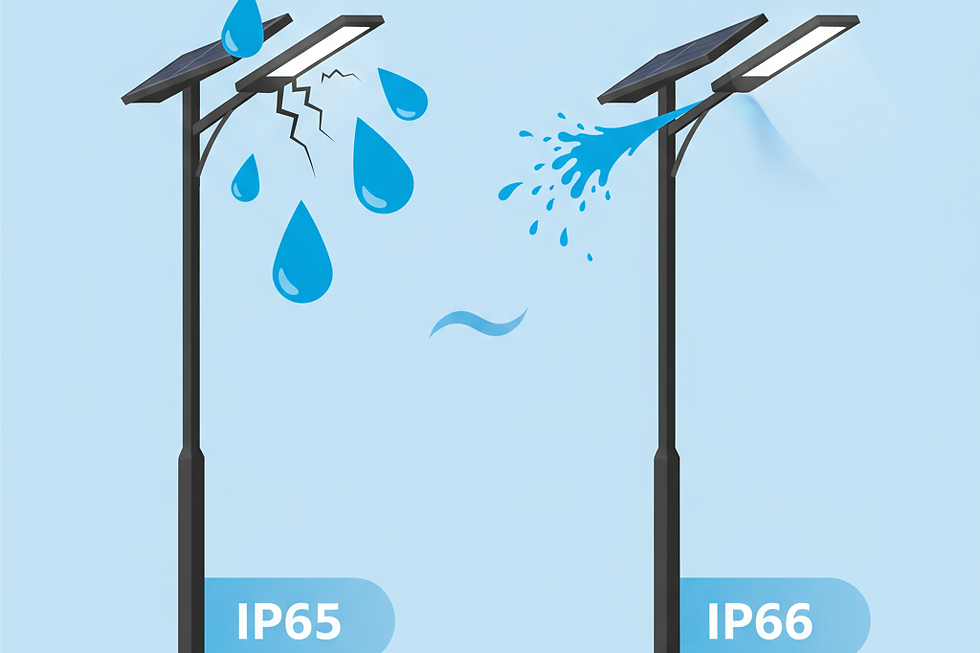Procuring China Solar Street Lights: 3 Critical Technical Standards 90% of Project Managers Misinterpret
- coco wang
- 3天前
- 讀畢需時 6 分鐘
Procuring China Solar Street Lights: 3 Critical Technical Standards 90% of Project Managers Misinterpret

Introduction: The Sourcing Gamble That Puts Your Project at Risk
For any project manager overseeing an infrastructure or commercial development, sourcing solar street lights from China presents a compelling proposition: vast selection, competitive pricing, and rapid innovation. However, this landscape is also a minefield of technical specifications that can be easily misinterpreted. A decision based on a seemingly straightforward number on a datasheet can lead to catastrophic project failures, budget overruns, and a damaged professional reputation.
The common mistake is assuming that all standards are applied and verified equally. This assumption is the root of underperforming lighting systems that fail within the first year, leaving you with angry clients and unforeseen replacement costs. This article is not just another buyer's guide. It's a strategic deep dive into the three most commonly misunderstood technical standards, designed to arm you with the critical perspective needed to distinguish a reliable, long-term asset from a costly liability.
1. The IP Rating Illusion: Why ?Weatherproof? Isn't a Guarantee
One of the first specs you'll see is the IP rating, or Ingress Protection rating. It?s meant to be a simple indicator of a fixture's resistance to dust and water. However, a superficial understanding of this standard is a direct path to premature failure, especially in demanding environments.

1.1. The Critical Difference Between IP65, IP66, and IP67
The common rating, IP65, signifies protection against low-pressure water jets. Many project managers tick this box, assuming it?s sufficient for any outdoor setting. This is a critical error. An IP65-rated light may withstand normal rain but can easily fail during a powerful thunderstorm, exposure to cleaning jets, or in coastal areas with driving, salt-laden rain.
IP66 (Powerful Water Jets): This is the true minimum for robust, reliable outdoor lighting, ensuring the seals can withstand high-pressure, high-volume water streams from any direction.
IP67 (Temporary Immersion): For areas prone to flooding or extreme weather, IP67 provides a crucial layer of security, guaranteeing the fixture can survive being temporarily submerged in water.
1.2. The Domino Effect of Minor Ingress
A breach of the IP rating isn't always a sudden, catastrophic failure. For an engineer, the real concern is the slow, creeping death of the system. A small amount of moisture ingress leads to condensation on the inside of the lens, which drastically reduces light output and uniformity. This moisture then corrodes sensitive electronics on the PCB and battery terminals, leading to intermittent faults and, eventually, total system failure. What starts as a ?minor leak? becomes a major maintenance headache and erodes the project's lighting performance over time.
1.3. Verification: Beyond the Datasheet Claim
How do you ensure the IP rating is legitimate? For a procurement officer managing public funds, this is a non-negotiable point of due diligence.
Request Third-Party Test Reports: Do not rely solely on the manufacturer's datasheet. Ask for a complete IP rating test report from an accredited laboratory. This document is your proof of compliance.
Examine Physical Design: Look at the product's construction. Are the seals made from high-grade, UV-resistant silicone? Is the casing designed to shed water effectively? Does the cable gland provide a truly watertight seal? These physical details often reveal more than the paper specification.
2. The Wattage vs. Efficacy Trap: Paying More for Less Light
The most persistent myth in lighting procurement is that wattage equals brightness. This legacy thinking from the era of incandescent bulbs is dangerously misleading in the LED world. Focusing on wattage not only fails to guarantee performance but also inflates the total cost of your solar lighting system.

2.1. The Only Metric That Matters: Luminaire Efficacy (lm/W)
Wattage measures energy consumption (a cost), while Lumens measure light output (a performance metric). The key performance indicator that connects them is Luminaire Efficacy (lm/W), which tells you how efficiently the converts electricity into light.
System A (The Trap): A 50W light with a low efficacy of 110 lm/W. Total Light Output: 5,500 lumens.
System B (The Smart Choice): A 30W light with a high efficacy of 190 lm/W. Total Light Output: 5,700 lumens.System B is brighter, yet consumes 40% less energy. For a distributor, this is a powerful selling point: you're not just selling a light; you're selling superior technology that delivers better performance at a lower operational cost.
2.2. The ?Punishment? for Inefficiency: Oversized System Components
Choosing the inefficient 50W light triggers a costly chain reaction throughout the entire off-grid system. To power that extra 20W of consumption every hour, the system requires:
A Larger Solar Panel: This increases the initial purchase price and, critically, the wind load on the pole, potentially requiring a thicker, more expensive pole to ensure safety.
A Larger, Heavier Battery: This is often the most expensive component of the system. The need for a higher capacity battery significantly inflates the project's upfront cost and the long-term cost of battery replacement.This is a classic TCO (Total Cost of Ownership) blunder where a seemingly cheaper luminaire results in a far more expensive total system.
2.3. Heat: The Silent Killer of Performance
Low efficacy means a higher percentage of electrical energy is converted into waste heat rather than light. For an LED fixture, heat is the primary enemy. It accelerates the degradation of the LED chips (lumen decay) and shortens the lifespan of the electronic driver. A cooler-running, high-efficacy fixture inherently offers better long-term reliability?a crucial concern for any facility manager looking to avoid maintenance calls.
3. The Battery Deception: When ?Capacity? Hides a Short Lifespan
The battery is the heart and the primary life-limiting component of a solar street light. Misinterpreting battery specifications is the fastest way to a failed project, with lights going dark after just one or two seasons.

3.1. Chemistry is King: LiFePO4 vs. Ternary Lithium (NCM)
Manufacturers may advertise a battery's capacity (in Amp-hours or Watt-hours) without highlighting the underlying chemistry. This is a critical omission.
Lithium Iron Phosphate (LiFePO4): This is the gold standard for professional solar lighting. It offers superior thermal stability (making it safer in hot climates), a longer cycle life (2000-4000 cycles), and is less susceptible to degradation.
Ternary Lithium (NCM/NCA): While common in electric vehicles for its energy density, it is less stable at high temperatures and typically offers a significantly shorter cycle life (500-1000 cycles) in a solar lighting application. A project manager procuring lights for a hot climate who overlooks this detail is specifying a system destined for early failure.
3.2. Usable Capacity: The Depth of Discharge (DoD) Factor
A battery's stated capacity is not its usable capacity. To ensure a long lifespan, batteries should not be fully drained. The Depth of Discharge (DoD) specifies the percentage of the battery that can be safely used. A quality LiFePO4 system is designed for a DoD of 80-90%. Cheaper systems with lower quality cells may be limited to 50-60% DoD to preserve their lifespan. This means a 100Ah battery limited to 60% DoD only provides 60Ah of usable energy, drastically reducing the system's autonomy during cloudy days.
3.3. The Brains of the Operation: The Battery Management System (BMS)
The BMS is a small circuit board that acts as the battery's guardian. A high-quality BMS protects against overcharging, over-discharging, overheating, and short circuits. It also performs cell balancing to ensure the longevity of the entire battery pack. A supplier who cannot provide detailed specifications on their BMS is a major red flag. For an NGO coordinator deploying lights in a remote, off-grid community, a reliable, self-protecting battery system isn't a luxury?it's the only thing ensuring the project's long-term social impact.
Conclusion: From a Spec-Sheet Checker to a Value-Driven Partner
Moving beyond these common misinterpretations is the defining characteristic of a professional buyer. The conversation must shift from simplistic, single-metric questions to a more holistic, system-level evaluation.
Instead of ?Is it IP65?? ask, ?Can you provide the third-party IP66 test report for this fixture??
Instead of ?What?s the wattage?? ask, ?What is the certified luminaire efficacy in lm/W and the L70 lifetime of the LEDs??
Instead of ?What?s the battery Ah?? ask, ?What is the battery chemistry, the design DoD, the expected cycle life, and can I see the BMS specifications??
By asking these more intelligent, probing questions, you transform yourself from a passive price-taker into a savvy project partner. You force accountability and transparency, ensuring that the product you procure is not just compliant on paper, but robust, efficient, and reliable in the real world. This is how you protect your investment, guarantee project success, and build infrastructure that lasts.
Ready to Procure with Confidence?
Tired of navigating the spec sheet minefield and risking your project on ambiguous data? Let's engineer a solar lighting solution that's built for performance and longevity, not just a low price tag.
Contact the expert team at Novafuture Tech for a no-obligation project or product consultation. We believe in transparent data and reliable engineering.
Website: www.nfsolar.net
Email: cocowang@novafuture.net
WhatsApp: +8613013537907




留言